Posts Tagged ‘Casa Rocca Piccola’
-
Guests to history
One would probably spare only a few moments of consideration at the receipt of a wedding invitation. However, for Baron Igino de Piro d’Amico Inguanez, these endearing solicitations were cherished so much that he kept a collection of them, neatly separated according to their date and wrapped up together by a string.
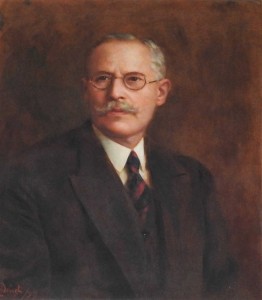 “Were it not for my grandfather’s interest to keep these wedding invitations, we would have lost this fascinating information which can be unravelled within each one of them,” remarked Marquis Nicholas de Piro as we walked towards an elegant table in one of the rooms at Casa Rocca Piccola where he had layed out a number of these invitations.
“Were it not for my grandfather’s interest to keep these wedding invitations, we would have lost this fascinating information which can be unravelled within each one of them,” remarked Marquis Nicholas de Piro as we walked towards an elegant table in one of the rooms at Casa Rocca Piccola where he had layed out a number of these invitations.I glanced out at the wide selection of wedding invitations tastefully set on the polished wooden surface, noticing the different sizes, shapes, writing, designs and paper. The earliest ones dated back to 1815, 1829 and 1832. They were quite plain and small, slightly bigger than a credit card, and written in Italian.
“Here are two of the prettiest ones” said the Marquis as he pulled them out of the rest.
These two invitations had been issued at the end of the 19th century. They were larger than the earlier ones and were quite different from each other. The one dated June 1896 was elegantly designed with an intricate cross at its corner and consisted of an invitation to the wedding between the noble Maria de Piro and Dr. Alfredo Stilon. The other one dated October 1899 was more colourful and rather than an invitation, it was more an announcement of the wedding which was to take place between the noble Maria Teresa de Piro and the Marquis Paolo Apap Bologna. Once again, both were written in Italian.
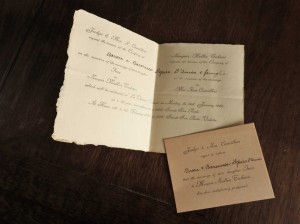 “Now look at this note which accompanies this wedding invitation,” said the Marquis as he handed it to me.
“Now look at this note which accompanies this wedding invitation,” said the Marquis as he handed it to me.The presentation of this wedding invitation was simpler than the previous two and the writing was in English. Here, Judge and Mrs L Camilleri were requesting the company of Baron and Baroness I de Piro d’Amico Inguanez and family to the wedding of their noble daughter Inez to Marquis Mallia Tabone on 26th January 1920. Yet this celebration was not destined to take place as a smaller card which was sent some days later informed those invited that this wedding had been indefinitely postponed.
 “From these invitations, one can also observe the traditional customs of the various eras. For example, this wedding invitation dated 1935 shows clearly that people who chose to get married during the period of Lent had to abide to some limitations.”
“From these invitations, one can also observe the traditional customs of the various eras. For example, this wedding invitation dated 1935 shows clearly that people who chose to get married during the period of Lent had to abide to some limitations.”Indeed, a formal note which was inserted together with the wedding invitation that was sent by Chev & Mrs E Moore and Mrs H Xuereb to announce the marriage of their daughter Alice Moore to Godfrey Xuereb, provided this information with direct instructions:
‘It is much regretted that in view of the restrictions imposed by Canon Law for weddings held in Lent, only a few guests may attend the religious ceremony at the Archbishop’s Palace.
You are therefore invited to meet the bride and bridegroom immediately after the ceremony at the residence at 4:00pm.’
 As we followed the different invitations that were sent along the years to Baron Igino and his family, we could also trace some of his friends and acquaintances, their residences, the chapels and churches where the marriages took place, and the selected locations for the wedding receptions. Although many of the churches still exist today, some of the street names had changed from Italian to English or were altered completely. A number of the residences mentioned have become quite renowned today whilst a few others were turned into commercial properties. Sadly, some of the lovely villas which provided exquisite entertainment in the bygone days were demolished to make place for large modern complexes.
As we followed the different invitations that were sent along the years to Baron Igino and his family, we could also trace some of his friends and acquaintances, their residences, the chapels and churches where the marriages took place, and the selected locations for the wedding receptions. Although many of the churches still exist today, some of the street names had changed from Italian to English or were altered completely. A number of the residences mentioned have become quite renowned today whilst a few others were turned into commercial properties. Sadly, some of the lovely villas which provided exquisite entertainment in the bygone days were demolished to make place for large modern complexes.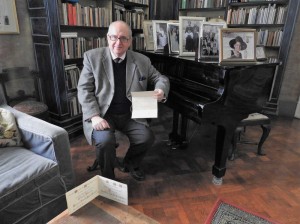 Amongst these, there was the wedding between Hilda Scicluna and Paymaster Lieutenant W Eric Brockman that took place on 4th March 1928. Their marriage was celebrated at the Archbishop’s Palace in Valletta which seems to have been quite a popular venue for such occasions. On the other hand, the reception was held at the bride’s parents residence that was located at 86 Strada Merkanti Valletta; a house which originally belonged to Sir Oliver Starkey, Bali of Aquila and Latin Secretary to Grand Master La Valette. Being an English Knight, he had assisted the Grand Master during the Great Siege of 1565 and was later given the privilege to be buried in the crypt of the Co-Cathedral of St John in Valletta, close to La Valette’s own burial place.
Amongst these, there was the wedding between Hilda Scicluna and Paymaster Lieutenant W Eric Brockman that took place on 4th March 1928. Their marriage was celebrated at the Archbishop’s Palace in Valletta which seems to have been quite a popular venue for such occasions. On the other hand, the reception was held at the bride’s parents residence that was located at 86 Strada Merkanti Valletta; a house which originally belonged to Sir Oliver Starkey, Bali of Aquila and Latin Secretary to Grand Master La Valette. Being an English Knight, he had assisted the Grand Master during the Great Siege of 1565 and was later given the privilege to be buried in the crypt of the Co-Cathedral of St John in Valletta, close to La Valette’s own burial place.The Cathedral in Mdina seems to have been another prominent place for marriages. On 24th January 1937, Adelina Maempel was married to Edwin England Sant Fournier. A reception followed at Villa Luginsland in 26 Boschetto Road, Rabat; a lovely villa which was built by Baron Max von Tucker, the German consul who was serving in Malta in the early 20th century. Unfortunately in recent years years, this remarkable place was in an abandoned state and had a haunting atmosphere.
 The only wedding invitation which came from Gozo looked quite distinguished and it boasted a silver wax seal. The marriage of Carmela and Paul Vella took place on 4th August 1937 and their reception was organized at the Duke of Ediburgh Hotel in Victoria, Gozo. Alas, in recent years, this splendid hotel that was beautifully constructed in Victorian architecture was demolished in order to make way for a commercial centre and a number of residential units.
The only wedding invitation which came from Gozo looked quite distinguished and it boasted a silver wax seal. The marriage of Carmela and Paul Vella took place on 4th August 1937 and their reception was organized at the Duke of Ediburgh Hotel in Victoria, Gozo. Alas, in recent years, this splendid hotel that was beautifully constructed in Victorian architecture was demolished in order to make way for a commercial centre and a number of residential units.“As you have already noted, some of these wedding invitations pertained to our relatives. Incidentally, this one which announces the marriage between my aunt Mona de Piro to Major John E J Nelson on 28th December 1940 is a favourite of mine, particularly because she was quite a character and she kept her high spirits even when she was aged more than ninety. Well, she’s there, looking at us!” the Marquis exclaimed as he pointed to a delightful portrait on the opposite wall.
My eyes met with those of a young, graceful girl, defiantly posing with an off-the-shoulder silver dress which melted in the greyish background behind her.
 “That portrait created much talk when her relatives saw it since it was regarded too sensual at the time. It was commissioned by her Italian boyfriend, Marquis Onofrio Bartolini Salinbeni, and the painting was done by Arthur Acton who lived in a palace in Florence. Onofrio was madly in love with Mona but unfortunately, their relationship ended and when she returned to Malta, a relative of hers went to Italy to claim this painting since it was not deemed fit for him to keep it,” smiled the Marquis as he went to add some logs to the fire burning in the stylish hearth besides us.
“That portrait created much talk when her relatives saw it since it was regarded too sensual at the time. It was commissioned by her Italian boyfriend, Marquis Onofrio Bartolini Salinbeni, and the painting was done by Arthur Acton who lived in a palace in Florence. Onofrio was madly in love with Mona but unfortunately, their relationship ended and when she returned to Malta, a relative of hers went to Italy to claim this painting since it was not deemed fit for him to keep it,” smiled the Marquis as he went to add some logs to the fire burning in the stylish hearth besides us.A warm gush of air embraced the room as the logs protested and cracked and poured a glowing light over the wedding invitations lying in front of us. For a short spell, I thought that I could hear the tinkling of the glasses filled with red velvety wine and golden sizzling champagne as the guests toasted to the newly married couples.
(This article was published in the Weddings Supplement issued with The Sunday Times of Malta dated 13th March 2016)
-
To die for a piece of bread
Although Carnival is generally associated with fun, exuberance and colour, it was sadness, tragedy and darkness which marked this festive season on 11th February 1823, after more than a hundred children died in Valletta. Details of this terrible tragedy are immortalized in black and white in the Malta Government Gazette of Friday, 14th February 1823 which is archived at the National Library of Malta in Valletta.
Initially, news of this tragedy was recorded as a Government Notice in the Malta Government Gazette (No. 557) by Richard Plasket, Chief Secretary to Government, wherein he declared that an investigation was taking place in order to obtain any possible evidence regarding this fatal accident. A published report of these findings was later annexed as a Supplement (pp. 3391-2) to the same journal of 14th February 1823.
In this long report, Plasket includes information that was provided to him by the Archbishop of Malta, persons examined before the Magistrates of Police which comprised both relatives of the victims and other individuals who were present during this incident, and also a medical report related to this case.
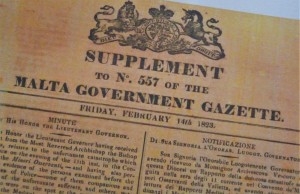 At the beginning of this statement, he furnishes a context for this mishap wherein he mentions that in those years, during the last days of the Carnival celebrations, it had become a tradition to gather a group of boys aged from 8 to 15, who came from the lower classes of Valletta and the Three Cities, to participate in a particular activity. In this event, children who opted to join were taken in a procession to Floriana or elsewhere, and after attending mass, they received some bread which was financed by the Government and other beneficiaries. The main aim of this activity was to protect the children by keeping them out of the riot and confusion of the Carnival that took place in the streets of these cities. The arrangement of this procession was under the responsibility of the Ecclesiastical Directors who taught Cathecism.
At the beginning of this statement, he furnishes a context for this mishap wherein he mentions that in those years, during the last days of the Carnival celebrations, it had become a tradition to gather a group of boys aged from 8 to 15, who came from the lower classes of Valletta and the Three Cities, to participate in a particular activity. In this event, children who opted to join were taken in a procession to Floriana or elsewhere, and after attending mass, they received some bread which was financed by the Government and other beneficiaries. The main aim of this activity was to protect the children by keeping them out of the riot and confusion of the Carnival that took place in the streets of these cities. The arrangement of this procession was under the responsibility of the Ecclesiastical Directors who taught Cathecism.Indeed, according to this tradition, on the 10th February 1823, some children were taken to attend mass at Floriana and were then accompanied to the Convent of the Minori Osservanti in Valletta (today known as the Convent of the Franciscans of St Mary of Jesus or Ta’ Ġieżu) where they were given bread without any difficulty or trouble. The same ritual was intended to take place the day after. Yet no one had any idea that a series of errors would eventually lead to such a great tragedy.
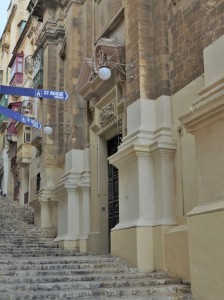 Everything started according to plan on 11th February 1823. The children were gathered in a group and were taken to mass at Floriana. However, when the ceremony lasted an hour longer than usual, the children’s procession to the Convent in Valletta coincided with the end of the Carnival celebrations, when a great number of jubilant people were returning home. This led to the next blunder, as a number of adults and children who were passing by and who knew of this tradition, secretely mixed in with the other boys in order to share the bread which would be distributed.
Everything started according to plan on 11th February 1823. The children were gathered in a group and were taken to mass at Floriana. However, when the ceremony lasted an hour longer than usual, the children’s procession to the Convent in Valletta coincided with the end of the Carnival celebrations, when a great number of jubilant people were returning home. This led to the next blunder, as a number of adults and children who were passing by and who knew of this tradition, secretely mixed in with the other boys in order to share the bread which would be distributed.In line with the usual arrangement, these boys were to enter into a corridor of the Convent from the door of the vestry of the Church, and were to be let out through the opposite door of the Convent in St Ursula Street, where the bread was to be distributed. In order to prevent the boys who received their share from reentering to take a second helping of bread, it became customary to lock the door of the vestry. Yet this time, since the children were late, this door was left open for a longer time so that they could enter. As the sun was setting and darkness crept in, nobody realized that other men and boys who did not form part of the original group were entering too.
Soon, the boys who were queuing in the corridor found themselves being pushed by these trespassers as they forced themselves in. The situation worsened when eventually the vestry door was closed as usual and the children were shoved further at the end of the corridor where a door stood half open so that no one could get back in a second time.
That day was certainly ill-fated when further mistakes continued to occur. In fact, a lamp which was usually lit in the corridor was somehow put out, leaving the overcrowded area in total darkness. This confused the people even more and as they tried to push themselves forward in order to get out, the boys who were at the front fell down a flight of eight steps on top of each other, thereby blocking further the door which happenned to open inwards.
Suddenly, both those who were distributing the bread and the Convent’s neighbours began to hear children shrieking out. They ran to give their assistance but a lot of time was wasted as they tried to open the two doors which led to the corridor in order to reach the people inside.
Eventually, many children were taken out fainting but recovered soon. Others appeared lifeless but were brought to their senses some time afterwards. Regretfully, 110 boys from 8 to 15 years of age perished from suffocation when they were pressed together in such a small place or because they were trampled upon.
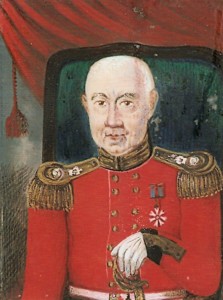 After investigating this accident, the Lieutenant Governor concluded that this was an unfortunate accident caused by the succession of errors mentioned above. Consequently, no one was accused for the death of these children since these acts were not done on purpose to harm them. In fact, Plasket commented that everyone had collaborated to assist these poor boys and even the victims’ relatives had allowed the police and the soldiers to work speedily and diligently in order to save as many children as possible. He insisted that were it not for this, the tragedy could have been much worse.
After investigating this accident, the Lieutenant Governor concluded that this was an unfortunate accident caused by the succession of errors mentioned above. Consequently, no one was accused for the death of these children since these acts were not done on purpose to harm them. In fact, Plasket commented that everyone had collaborated to assist these poor boys and even the victims’ relatives had allowed the police and the soldiers to work speedily and diligently in order to save as many children as possible. He insisted that were it not for this, the tragedy could have been much worse.As I followed further this narrative by focusing on the names mentioned in Plasket’s report, I succeeded to trace the Captain of the Malta Fencibles who led the soldiers during this tragic moment. It was his descendant, Marquis Nicholas De Piro who led me to see Colonel Marquis Giuseppe De Piro’s portrait which is located at Casa Rocca Piccola in Valletta.
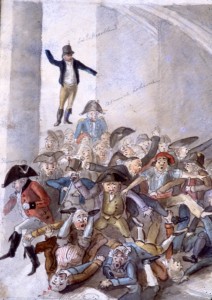 An interesting discussion ensued between us during which the present Marquis informed me also about General Sir George Whitmore who headed the Royal Engineers’ detachment on Malta as its Colonel Commandant between 1811 and 1829. Whitmore had written about his experiences in Malta and had also produced some illustrations related to our islands. Interestingly, Marquis Nicholas De Piro was in possession of a copy of one of these ancient illustrations in the form of a very small slide, which showed some individuals being trampled upon by a group of other people. He wondered whether this slide could be portraying this misfortunate accident of the Carnival of 1823. Yet no children are included in this representation and so it is not clear whether it actually depicts this narrative.
An interesting discussion ensued between us during which the present Marquis informed me also about General Sir George Whitmore who headed the Royal Engineers’ detachment on Malta as its Colonel Commandant between 1811 and 1829. Whitmore had written about his experiences in Malta and had also produced some illustrations related to our islands. Interestingly, Marquis Nicholas De Piro was in possession of a copy of one of these ancient illustrations in the form of a very small slide, which showed some individuals being trampled upon by a group of other people. He wondered whether this slide could be portraying this misfortunate accident of the Carnival of 1823. Yet no children are included in this representation and so it is not clear whether it actually depicts this narrative.My research ended at Ta’ Ġieżu Church and I watched in silence the area where these children lost their lives. Sadness engulfed me when I climbed up the steps on my way back while pondering how these children could end in this way for a piece of bread.
(This article was published in the Carnival Supplement issued with the Times of Malta dated 3rd February 2016)
-
Maċ-ċaqċiq taċ-ċombini
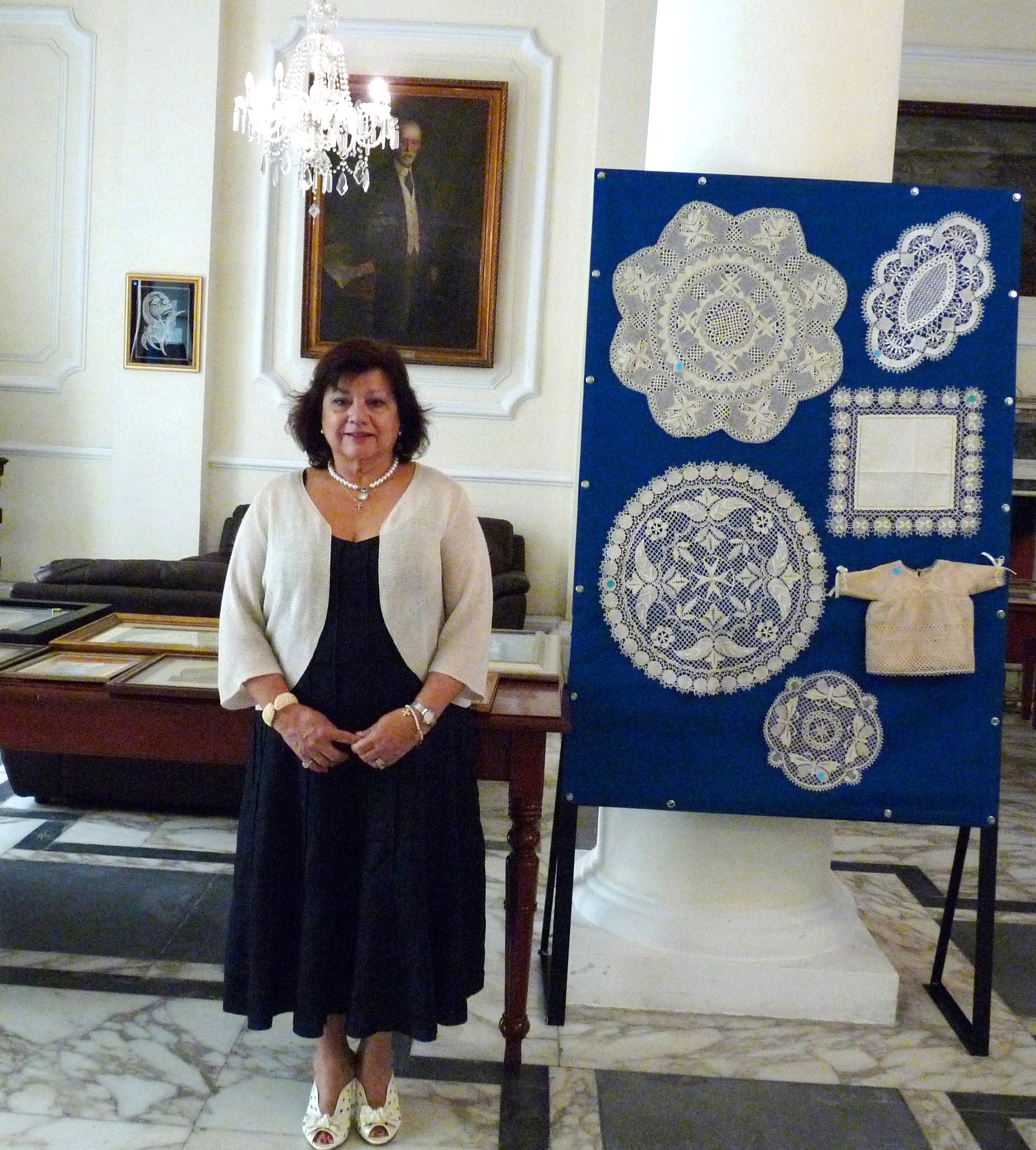
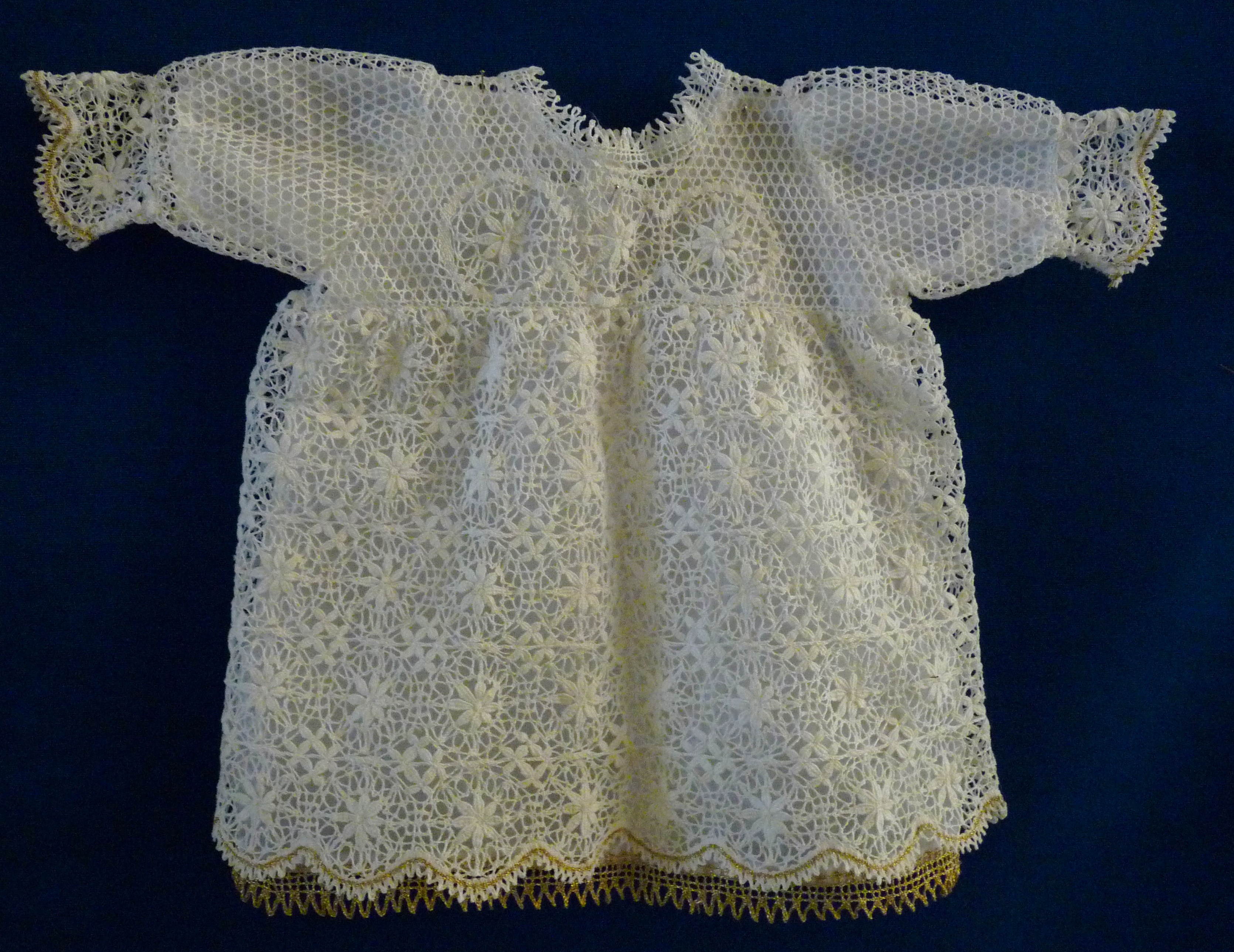
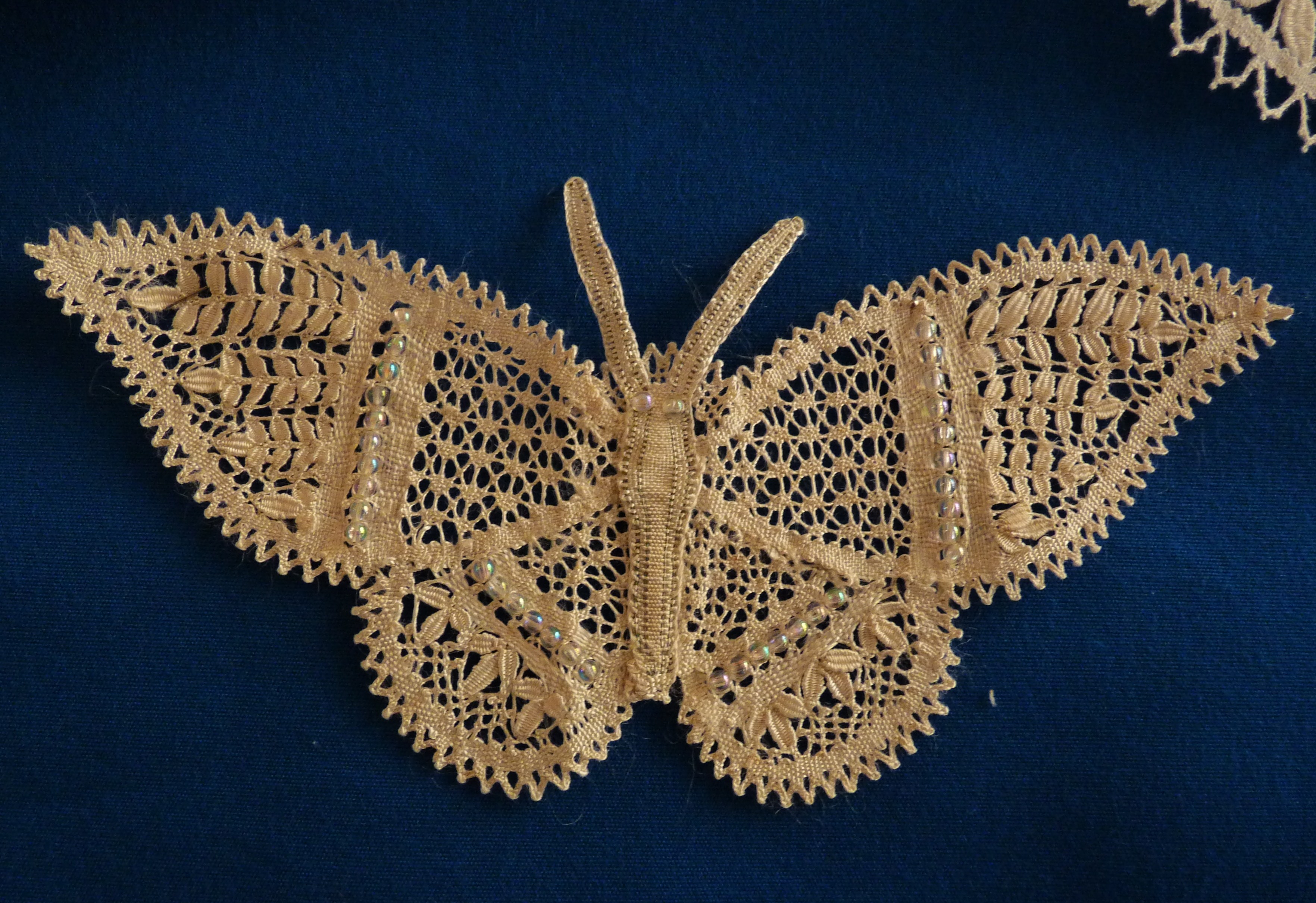
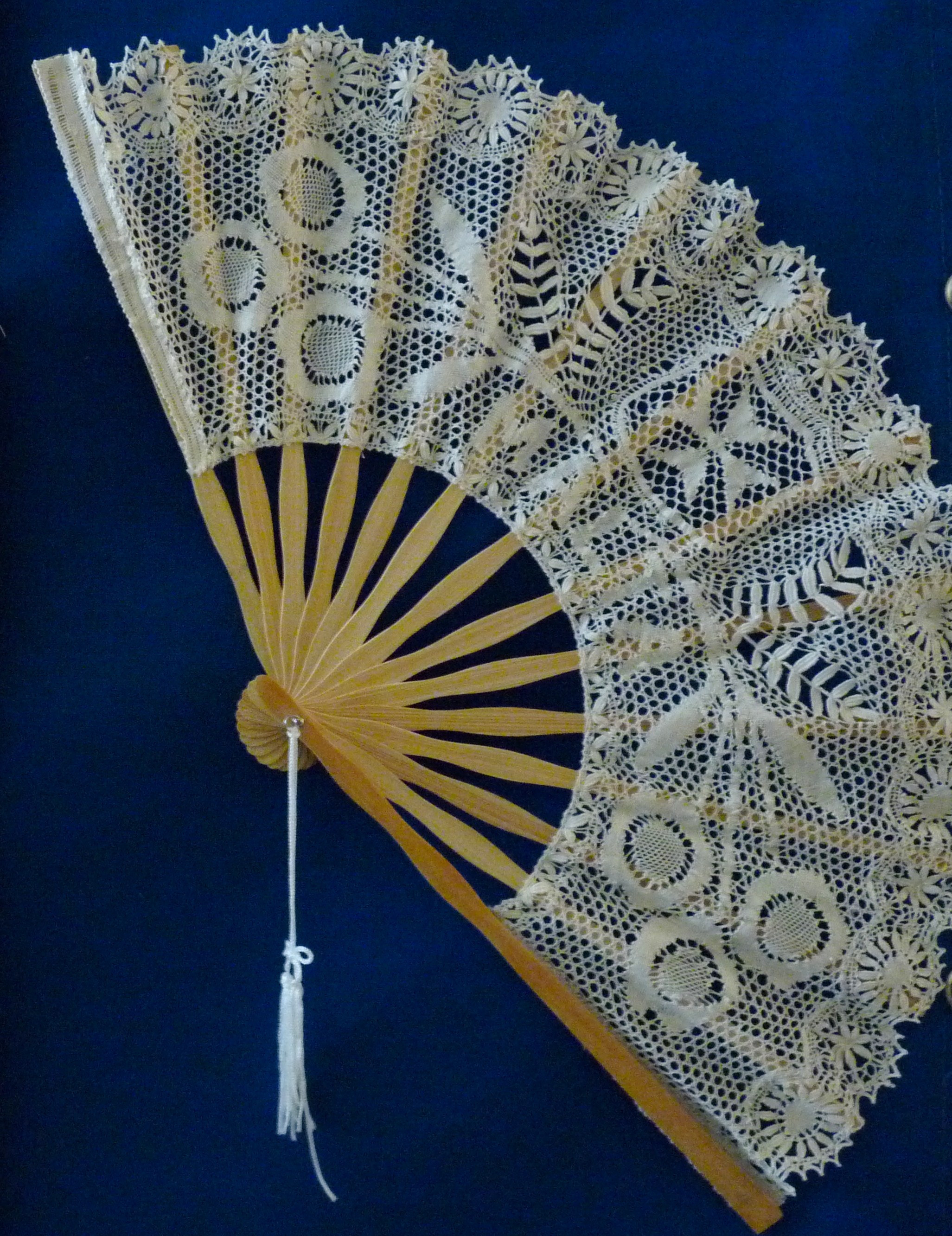
Jingħad li s-sengħa tal-bizzilla ġiet introdotta f’Malta fi żmien il-Kavallieri ta’ San Ġwann. F’dak il-perjodu, il-bizzilla kienet meqjusa bħala xi ħaġa prestiġġjuża ferm peress li kienet għalja ħafna. Kienu jilbsuha kemm l-irġiel u kif ukoll in-nisa nobbli, kollha b’kompetizzjoni bejniethom dwar kemm se jperrċu bizzilla fuq ħwejjiġhom sabiex juru kemm jesgħu bwiethom. Uħud minn dawn l-individwi għadna nistgħu narawhom jiddandnu bil-bizzilla tagħhom sal-ġurnata ta’ llum permezz tal-kwadri tagħhom li tpittru f’dawk is-snin.
Illum is-sinifikat tal-bizzilla nbidel ħafna u daqstant ieħor il-moda tagħha. M’għadikx tara rġiel jilbsu l-bizzilla u n-nisa li jżejjnu biha l-ħwejjeġ tagħhom, naqsu ferm. Nazzarda biex ngħid illi ħafna minna, ngħoddu l-bizzilla bħala xi ħaġa ta’ dari, filwaqt li nqisu lin-nisa li jaħdmu l-bizzilla fuq it-trajbu bħala rappreżentazzjoni ta’ sengħa tradizzjonali.
Esebizzjoni u kompetizzjoni tal-bizzilla fil-Każin Malti
Madanakollu, hekk kif il-ġimgħa li għaddiet mort inżur l-esebizzjoni tal-bizzilla li kien hemm fil-Każin Malti, l-Belt Valletta, fejn iltqajt mal-organizzatriċi tagħha, Margaret Farrugia, intbaħt li kelli idea pjuttost żbaljata dwar il-valur kontemporanju tal-bizzilla u s-sengħa tagħha.
Nibda biex insemmi illi l-faxxinu tal-arkitettura u tal-ambjent tal-Każin Malti xeraq ferm ma’ din l-esebizzjoni rikka li kienet tikkonsisti minn madwar 150 biċċa xogħol tal-bizzilla. Infatti waqt din l-intervista, smajt kummenti favorevoli ħafna mill-pubbliku li attenda.
Kien hemm kemm Maltin u kif ukoll barranin li daħlu jiflu l-bizzilla esebita. Fost dawn, sirt naf li kien hemm ukoll uħud mill-parteċipanti ta’ din l-esebizzjoni, li kienet ukoll kompetizzjoni, li kienu qegħdin jixtarru aktar mill-qrib liema kienu l-isbaħ biċċiet fil-fehma tagħhom.
“L-għan prinċipali ta’ din il-kompetizzjoni huwa li naraw lin-nies jikkompetu bejniethom dwar min se joħroġ bl-iktar bizzilla oriġinali u sabiħa,” stqarret Margaret. “Kien hemm żmien meta l-bizzilla kienet ser tmut mewta naturali minħabba li beda jonqos l-interess fiha. Iżda llum hawn numru ta’ individwi li qed jipprowovuha mill-ġdid u b’hekk l-involviment fis-sengħa tal-bizzilla qiegħed jerġa’ jitrawwem.”
Din il-kompetizzjoni tal-bizzilla bl-isem ta’ The Malta Lace Competition ġiet imnhedija għall-ewwel darba tmien snin ilu mill-Markiż Nicholas De Piro.
“Il-bizzilla minn dejjem kienet għal qalbi iżda kien meta ltqajt ma’ żewġi li bdejt nersaq lejha aktar mill-qrib. Maż-żmien tgħallimt is-sengħa tal-bizzilla u mbagħad għent lil ħaddieħor jitħarreġ fiha. Kont ukoll nifforma parti mill-bord li rregolarizza l-kriterji li jiddefinixxu l-bizzilla Maltija u li waqqaf il-Malta Lace Standard. Għal xi żmien kont ukoll responsabbli mill-assessjar tar-rapporti tal-istudenti tas-City & Guild Creative Skills Certification – Regional Bobbin Lace. Fis-sena 2000 twaqqfet il-Malta Lace Guild u għal disgħa snin konsekuttivi organizzajt l-esebizzjoni bl-isem Malta Lace Day,” spjegatli Margaret.
“Ormaj kelli esperjenza ta’ aktar minn 40 sena fil-qasam tal-bizzilla u għalhekk, darba minnhom, il-Markiż Nicholas De Piro stedinni biex nibda nieħu ħsieb proġett li hu ħareġ bih. Il-Markiż għandu għal qalbu ħafna s-sengħa tal-bizzilla u bħali kien kuntent li din kienet reġgħet bdiet tqum fuq saqajha. Madanakollu hu xtaq joħloq xi tip ta’ inċentiv sabiex jitħajjru aktar nies lejn il-bizzilla u b’hekk nibtet l-idea ta’ din il-kompetizzjoni. Kien b’hekk li jiena sibt ruħi norganizza l-esebizzjoni/kompetizzjoni The Malta Lace Competition.”
“Għal dawn l-aħħar snin, il-kompetituri kienu jġibu x-xogħolijiet tagħhom f’Casa Rocca Piccola u mbagħad dawn kienu jiġu esebiti f’żewġt ikmamar ta’ din id-dar ħalli l-parteċipanti jkunu jistgħu jaraw ix-xogħolijiet li jkunu ttellgħu. Pero’ meta bdejna naraw l-interess dejjem jiżdied, tant li dawn il-kmamar ma baqgħux jesgħuna, xtaqna nsibu post akbar sabiex idealment anki l-pubbliku jkun jista’ jżur dawn ix-xogħolijiet. B’hekk, għall-ewwel darba dis-sena, ftaħna l-esebizzjoni fil-Każin Malti u ninsabu kuntenti ferm bl-ammont ta’ nies li qed iżuruha.”
Il-Ħadd li għadda aktar minn 30 rebbieħ ta’ diversi kategoriji qasmu bejniethom bi €3000 premijiet li sponsorja HSBC Bank (Malta) għal din il-kompetizzjoni.
In-negozju tal-bizzilla fis-snin ta’ qabel
Intant, waqt din id-diskussjoni Margaret qaltli li minn ċkunitha kienet tħossha affaxxinata meta kienet tara n-nisa Għawdxin jaħdmu l-bizzilla quddiem il-bieb tad-dar tagħhom.
“Kont nintilef inħares lejhom u kont nistagħġeb kif jirnexxielhom ilaħħqu ma’ dawk il-mijiet ta’ ċombini li jkollhom imdendlin. Darba minnhom iltqajt ma’ anzjan Għawdxi u staqsejtu jekk kienx hemm xi ħadd li jgħallem il-bizzilla. Hu laqqgħani ma’ waħda u għalkemm għall-ewwel bżajt li ma kienx ser jirnexxieli nitgħallem, ma domtx ma sibt irkaptu,” ftakret Margaret.
“Fis-snin 30, il-familja ta’ żewġi kellhom casa bottega quddiem il-knisja tal-Karmnu fi Strada Teatru, l-Belt. Huma kienu jimpurtaw id-drappijiet u l-ħajt tal-bizzilla u anki jbiegħu l-bizzilla. Dak iż-żmien, kienet xi ħaġa komuni li wieħed ikun joqgħod fis-sular ta’ fuq, filwaqt li s-sular t’isfel tad-dar ikun ħanut.”
Ftit ftit Margaret ġiet introdotta wkoll f’dax-xogħol hekk kif f’xi Sibtijiet, bdiet titla’ Għawdex ma’ xi ħadd minn ħutha ħalli twassal l-ordnijiet tal-ħajt tal-bizzilla lin-nisa Għawdxin. U minn hemm bdiet tifhem aħjar kemm kienet tinħadem il-bizzilla f’Għawdex u kif kienet qed tiġi kkumerċjalizzata.
It-tpartit tal-bizzilla mal-merċa
“Niftakar li fis-snin sittin, fost il-klijenti tagħna kien hemm Għawdxi, ċertu Ġużeppi l-Qass, li kellu ħanut tal-merċa fi Pjazza Savina r-Rabat, Għawdex. Dan kellu ftehim man-nisa Għawdxin sabiex huma jkunu jistgħu jpartu l-bizzilla li kienu jaħdmu ġewwa d-djar tagħhom mal-prodotti tal-merċa fil-ħanut tiegħu. Imbagħad hu kien jinżel Malta darba fil-ġimgħa b’din il-bizzilla sabiex ibiegħha fil-ħanut ta’ Fedele, li kien in-nannu ta’ żewġi,” bdiet tirrakkuntali Margaret.
“Imbagħad aħna konna ngħaddu din il-bizzilla lill-kunventi tas-sorijiet sabiex dawn jimmuntawha fuq id-drapp bl-idejn ħalli b’hekk inżommu l-prestiġju tal-prodott li jibqa’ kollu kemm hu maħdum bl-idejn. Wara, konna nbiegħu dawn il-prodotti lill-Maltin jew lit-turisti.”
Meta miet Fedele, dan il-ħanut għalaq u minflok, Margaret baqgħet tieħu ħsieb ix-xogħol tal-bizzilla mid-dar tagħha.
Il-bizzilla bħala parti mill-wirt kulturali tagħna
“Jiena għadni għaddejjha b’dax-xogħol għax nemmen bis-sħiħ li m’għandniex inħallu dan il-wirt kulturali tagħna jintilef. M’għandix ħanut imma n-nies jafu bija u naħdem skont l-ordnijiet li jkolli. Meta jkolli ordnijiet kbar, għandi wkoll lista ta’ nisa li jaħdmu bizzilla sabiħa u nqassam ix-xogħol bejnietna kif ikun jeħtieġ biex inlaħħqu mat-talba ta’ dak li jkun.”
Infatti l-fama ta’ Margaret waslet ukoll s’għand l-ogħla awtoritajiet lokali hekk kif mhux darba u tnejn li xogħolijietha jiġu ordnati mill-Gvern Malti sabiex dawn jiġu rregalati lid-dinjitarji li jżuru pajjiżna.
“Għandi l-unur ngħid ukoll illi diversi palazzi hawn Malta, fosthom dak ta’ San Anton u Verdala, huma armati bil-bizzilla tiegħi. Barra minn hekk, kelli l-privileġġ illi naħdem il-bizzilla għall-ilbies formali tal-ewwel imħallef mara, Anna Felice, fejn ix-xogħol sar b’disinn tiegħi li kien jinkorpora fih fjuri, is-salib ta’ Malta u għamla ta’ miżien tal-ġustizzja bi stil barokk.”
“Intant, is-sena li għaddiet ħdimt ukoll il-bizzilla għal velu tat-tieġ fejn ikkuppjajt fjura mill-libsa u mbagħad ħdimt fjura wara fjura matul il-bordura kollha. Domt madwar ħames xhur għaddejjha fuqu fejn b’kollox ħadt mat-800 siegħa!”
Meta wieħed jagħraf l-ammont ta’ siegħat li jirrikjedi dan ix-xogħol jifhem aħjar il-għala l-bizzilla hija meqjusa bħala xi ħaġa rikka u ta’ valur.
“Il-bizzilla trid ħafna passjoni u mħabba biex taħdimha għax tirrikjedi ħafna attenzjoni u ħin. Imma mbagħad, meta tara l-oġġett lest, jagħtik sodisfazzjon kbir, mhux biss għax jiġi sabiħ iżda wkoll għax taf li permezz tiegħu, inti qed iżżomm ħajja tradizzjoni antika Maltija,” saħqet Margaret.
It-tagħlim tal-bizzilla
Skoprejt li Margaret għadha tgħallem il-bizzilla privatament u għalhekk staqsejtha x’età u x’karatteristiċi jrid ikollu persuna biex jitħajjar għal din is-sengħa.
“M’hemm l-ebda limitu ta’ età. Infatti, mhux darba u tnejn li jipparteċipaw it-tfal f’din il-kompetizzjoni u naturalment, biex nagħmlulhom il-qalb, aħna naġevolawhom daqsxejn,” qaltli. “Anki xi rġiel hemm li jaħdmu l-bizzilla u infatti dis-sena għandna xi xogħol li nħadem mill-irġiel. Però l-maġġoranza huma nisa ta’ bejn il-35 u l-65 sena.”
Għalkemm forsi hemm min minnkhom li huwa xi ftit nervuż u allura jaħseb li dax-xogħol ma jgħoddx għalih, Margaret żguratni illi fir-realtà l-ħidma tal-bizzilla tikkalmak peress li jkollok bżonn tikkonċentra ħafna fuq li qed tagħmel. U b’hekk għal ftit tal-ħin, tkun tista’ tinsa l-problemi l-oħra kollha.
Bejn bizzilla u oħra
Aħna u nduru mal-bizzilla esebita, Margaret bdiet tfehemni aktar fid-dettall dwar id-differenza li kien hemm bejn xogħol u ieħor. F’ħin minnhom, waqafna quddiem libsa tal-magħmudija maħduma b’ħajt ta’ kulur abjad silġ li kienet tidher fina mmens.
“Tidher daqstant fina għax hija maħduma b’ħajt irqiq ħafna. Dan it-tip ta’ ħajt jagħti lill-oġġett aktar preġju minħabba li huwa aktar metikoluż biex taħdmu u għalhekk ix-xogħol jieħu aktar żmien. Apparti minn hekk, min ħadem din il-libsa, għaqqad b’galbu kbir l-istrixxi tal-bizzilla flimkien sabiex ipproduċa din il-meravilja,” urietni kburija Margaret.
Biex inkun nista’ nifhem aktar xi trid tgħid, hija ħaditni nara xogħol li kien maħdum b’ħajt eħxen u hemmhekk stajt nikkonferma illi għalkemm il-bizzilla xorta waħda kienet sabiħa, id-dettall ma kienx qed joħroġ ċar daqs kemm kien f’xogħolijiet oħra fejn intuża ħajt irqaq.
“Dawn huma l-karatteristiċi li jkunu qed iħarsu lejhom dawk li jiġġudikaw ix-xogħolijiet rebbieħa. Il-materjal li jintuża għal bizzilla jaffetwa ħafna x-xogħol finali. Ngħidu aħna l-ħajt tal-għażel iżomm il-bizzilla wieqfa u sabiħa, mentri l-qoton iħalli xogħol mitluq.”
Innutajt li kien hemm bizzilla ta’ kuluri diversi u kelli kurżità jekk dan jaffetwax il-valur tal-oġġett.
“Il-kuluri li jintużaw ma jagħmlu l-ebda differenza fil-valur. Però, jista’ jkun li l-bizzilla s-sewda hija xi ftit aktar apprezzata minħabba li mhux kulħadd kapaċi jaħdimha. L-iswed hu kulur imprekattiv biex taħdem bih u trid tkun tassew professjonali biex taħdmu. Infatti, ftit huma li jużaw dak il-kulur u għalhekk il-bizzilla ta’ dak il-lewn hija mfittxija ferm minn uħud.”
Xtaqt naf jekk hemmx differenza bejn il-bizzilla Maltija, dik Għawdxija u dik barranija.
“M’hemmx differenza bejn il-bizzilla Maltija u dik Għawdxija, ħlief li l-Għawdxin tgħallmu jikkummerċjalizzawha aktar minna l-Maltin. Madanakollu hemm varjanza bejn il-bizzilla Maltija u dik barranija minħabba li nużaw tip ta’ trajbu differenti,” fehmitni Margaret.
“It-trajbu tagħna huwa magħmul miz-zkuk tal-iżbul imnixxef. Għandu forma pjuttost dejqa u huwa twil madwar 22 pulzier. Għaldaqstant, il-bizzilla li nipproduċu aħna hija magħrufa bħala ‘continuous lace’ għax tinħadem għad-dritt u tibqa’ nieżla fit-tul. Dan ifisser li aħna ma nistgħux indawwru t-trajbu u nkabbru l-bizzilla kemm irridu, kif jagħmlu f’pajjiżi oħra bi trajbi differenti.”
Margaret spjegatli kif l-għodda prinċipali fis-sengħa tal-bizzilla huma t-trajbu, iċ-ċombini, il-labar, il-ħajt u x-xempju (id-disinn).
“Il-bizzilla hija maħduma b’żewġ tipi ta’ punti li huma: il-punt u n-nofs punt. Dan tal-aħħar joħloq toqba. U mbagħad skont kif iddawwar iċ-ċombini joħroġ id-disinn.”
Il-valur tal-bizzilla llum
Fl-esebizzjoni kien hemm kull xorta ta’ xogħol. Lili laqtitni ferm umbrella kbira tal-bizzilla li ridt sebgħa għajnejn biex tħares lejha, aħseb u ara biex taħdimha! Pero’ kien ghad fadalli mistoqsija ttambar f’moħħi: il-bizzilla għadha valida llum?
“Jien għandi kollezzjoni kbira ta’ bizzilla u jekk tiġi d-dar, qisha mużew. Għaldaqstant, kull fejn insib opportunità nħobb nilbes il-bizzilla. Għandi kappa tal-bizzilla li tiġbed tassew l-għajn u ħafna jistaqsuni dwarha meta noħroġ biha,” qaltli Margaret. “Hija ħasra meta wieħed ikollu xi bizzilla antika u jħalliha magħluqa ġo xi kexxun għax hekk tittebba’ biss tista’ u mbagħad ikun tassew diffiċli li wieħed inaddafha. Irridu niftakru li dawn l-affarijiet ħadu siegħat twal biex inħadmu u għalhekk imqar b’rispett lejn min ħadimhom, għandna ngħożżuhom u ngawduhom. Il-bizzilla hija xi ħaġa femminili għall-aħħar u personalment naħseb li hija xi ħaġa ta’ faxxinu kbir.”
“Bħala validità tal-bizzilla, nistgħu ngħidu li fil-qasam ekkleżjastiku, il-bizzilla baqgħet dejjem iżżomm postha, kemm minħabba li baqgħet tintuża fil-paramenti tal-qassis u anki fl-aċċessorji li jintużaw fuq l-artali. Imbagħad hemm ukoll l-ilbiesi tal-magħmudija u tat-tieġ, ix-xallijiet u l-veli. Barra minn hekk, issa qed taqbad ukoll id-drawwa illi jingħata kwadru bl-arma tar-razza maħduma bil-bizzilla.”
Domna ħafna aktar nimirħu dwar is-suġġett tal-bizzilla, sakemm finalment wasalt biex nitlaq.“Dawn is-snajja u t-tradizzjonijiet antiki għandhom jibqgħu jinteressawna għax huma parti essenzjali minn dak li jagħmilna Maltin,” saħqet Margaret. “Għalija m’hemmx kuntentizza isbaħ minn dik li jkollok il-ħin biex tpoġġi fuq siġġu komdu ġewwa bitħa għad-dell ta’ xi siġra sabiħa u toqgħod taħdem il-bizzilla għall-kwiet, bis-silenzju miksur biss miċ-ċaqċiq ħelu taċ-ċombini.”
Għal aktar informazzjoni dwar il-bizzilla jew dwar din il-kompetizzjoni annwali, tistgħu ċċemplu lil Margaret Farrugia fuq 99206273.
(Dan l-artiklu ġie ppubblikat fis-sensiela KOBOR IL-MALTI (24 parti) fit-Torċa tas-26 t’Ottubru 2014)
Travelogue
Archives
| M | T | W | T | F | S | S |
|---|---|---|---|---|---|---|
| « Jan | ||||||
| 1 | 2 | 3 | 4 | 5 | 6 | 7 |
| 8 | 9 | 10 | 11 | 12 | 13 | 14 |
| 15 | 16 | 17 | 18 | 19 | 20 | 21 |
| 22 | 23 | 24 | 25 | 26 | 27 | 28 |
| 29 | 30 | |||||
Recent Posts
- A MATTER OF FATE
- MALTA’S PREHISTORIC TREASURES
- THE MAGIC IS IN THE DETAIL
- THE SELLING GAME
- NEVER FORGOTTEN
- Ġrajjiet mhux mitmuma – 35 sena mit-Traġedja tal-Patrol Boat C23
- AN UNEXPECTED VISIT
- THE SISTERS OF THE CRIB
Comments
- Pauline Harkins on Novella – Li kieku stajt!
- admin on IL-KARNIVAL TRAĠIKU TAL-1823
- Albert on IL-KARNIVAL TRAĠIKU TAL-1823
- Martin Ratcliffe on Love in the time of war
- admin on 24 SENA ILU: IT-TRAĠEDJA TAL-PATROL BOAT C23